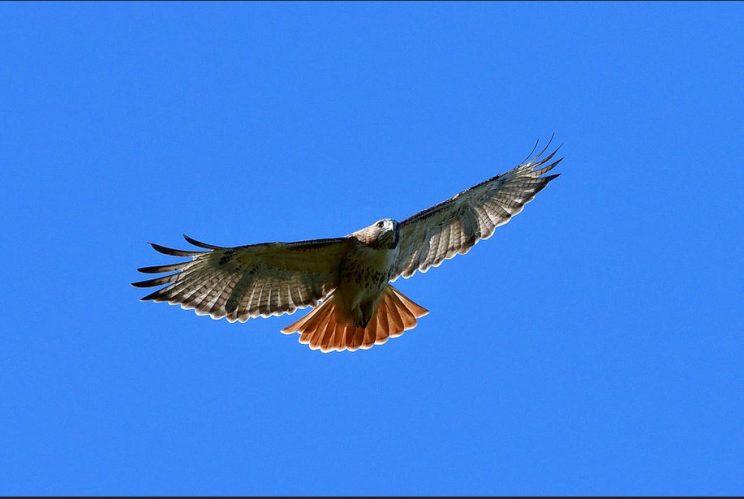by Kathleen Keefe
Every fall in High Park, you can count on two things. Migrating birds will pass overhead and people will come to watch them do it. The watchers gather on Hawk Hill, a small bump of earth rising just north of Grenadier Restaurant. Although more than 150 different kinds of birds may pass through on their way south, people come to Hawk Hill particularly to watch raptors, the meat-eating birds of prey.
Raptors seen from Hawk Hill include:
Turkey Vulture Cathartes aura
Osprey Pandion haliaetus
Bald Eagle Haliaeetus leucocephalus
Northern Harrier Circus cyaneus
Sharp-shinned Hawk Accipiter striatus
Cooper’s Hawk Accipiter cooperii
Northern Goshawk Accipiter gentilis
Red-shouldered Hawk Buteo lineatus
Broad-winged Hawk Buteo platypterus
Red-tailed Hawk Buteo jamaicensis
Rough-legged Hawk Buteo lagopus
Golden Eagle Aquila chrysaetos
American Kestrel Falco sparverius
Merlin Falco columbarius
Peregrine Falcon Falco peregrinus
While songbirds are hopping and hiding in the bushes, these raptors steal the show, large and steady in the sky, exhibiting their distinctive forms and flight styles.
Take the Cooper’s Hawk for example. These middle-distance flyers have short rounded wings and very long rudder-like tails for maneuvering through woodland canopies at high speed. Their flight style will catch your eye with a flap-flap-glide motion. In contrast, the Red-tailed Hawks with their longer, larger broad rounded wings and short wide tails are built for gliding. You will see just the occasional heavy wing beat from these birds soaring in wide circles overhead.
From September 1 to November 30, an official recorder spends each day on Hawk Hill. Other keen-eyed observers join the recorder with skyward gazes to spot, identify and count the raptors. Along with the data collected by more than 100 other North American Raptor observation sites, the weekly totals recorded at Hawk Hill are reported to the Hawk Migration Association of North America (HMANA). Cornell University is the final destination of all the data.
This important information alerts us to trends and changes in bird populations that signal problems. This very system informed the world in the 1970s of the drastic decline in young eagles and resulted in a ban on the pesticide DDT. While the data collection is official and invaluable, the main attraction to Hawk Hill is pure fun and wonder. Everyone is welcome and many people come to share in the adventure and excitement of tracking the birds on their annual fall migration.
Why Do They Leave in the Fall and Return in the Spring?
Migration to a warmer place is all about following the food, not about staying warm. Raptors eat animal protein. When cooler temperatures force these food sources (insects, mammals, reptiles, amphibians) into winter hiding for months of sleeping or eating stored reserves, the raptors must move to new hunting grounds. In their warmer southern haunts, these migrant birds of prey must share food and roosting sites with local resident birds. At that time of year there is enough to go around because both migrant and resident birds are feeding only themselves and not whole broods. However, come spring, the migrants must make the grueling trek back north where they will find plenty of nesting sites to choose from and many newly emerged animals to eat.
Turn Right at the Lake
Some raptors migrate great distances. For example, the Broad-winged Hawk flies more than 100 km a day for two months to cover 7000 km. Consequently, raptors use several strategies to prevent exhaustion. They often wait for a wind from the northwest. If the wind is blowing at the right angle, the extra push saves a lot of energy. They also take advantage of winds that blow against rising landforms, like the elevated southern edge of the park by Colborne Lodge. These vertical barriers force the air to ride up along the ridge and without much flapping, raptors are able to ride the updrafts like surfers ride waves.
Another labour-saving tactic is to ride thermals. Where land surfaces heat up in the sun, air rises over these warmer spots and offers raptors another free ride. They cover distance by soaring from one thermal to the next. There are no rising thermals over water and it is too risky for these birds to fly where they will have to expend energy by flapping their wings. If they run out of energy over water, they will drown. That is why many of the raptors fly south until they encounter Lake Ontario where they do a collective “whoa” right over High Park before turning right to follow the shoreline in a westerly direction.
At Home in High Park
High Park has become a permanent residence for a few hawks. A family of Red-tailed Hawks and a Cooper’s Hawk are now year-round regulars that have been fondly named by devoted Hawk Hillers. The birds behave like real characters providing great entertainment on Hawk Hill with their circling, calling, soaring, dive-bombing and performances of aerial acrobatics. Perhaps we may see growing numbers of raptors over-wintering or nesting in High Park with the increase in urban food sources such as rats and squirrels at birdfeeders.
























